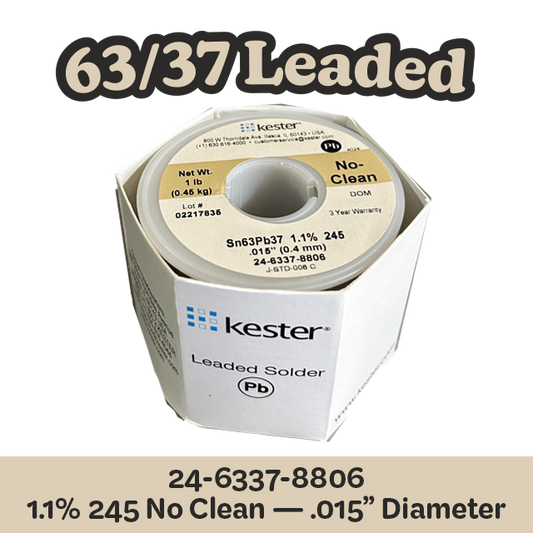Let's take a little time today to discuss how desoldering braid works, what it is, and how to use it.
We can start by discussing what it is. Desoldering braid, or wick as it is sometimes referred, is a spool of braided copper, available in a variety of gauges ranging from 18-42 AWG. It is used essentially as an eraser for solder. Whether you made a mistake or just need to rework something or replace a component, desoldering braid can help you remove the older solder so you can rework your board. There are other tools that work for desoldering as well, a solder pump for example which will suck up the unwanted solder. The advantage of the braid, however, is that it can be cut to size for more precise use, and it is less cumbersome than using a pump would be.
How does it work?
The way this works is that the copper wire, when heated on top of the solder you would like to remove, melts the solder beneath it, the solder will bond to the copper wire. You will quite literally watch it get sucked into the braid while you heat it, removing the solder from the board and leaving you with a clean surface to rework. It is relatively simple to use once you get the hang of it, you can start by following these steps:

- Place the end of the braid on over the section of solder you would like to remove.

- Then tin the tip of your soldering iron and place the tip on your braid and begin heating. Remember, the copper wire will begin to heat up so be aware of how close your fingers are to the wire.

- Once it gets hot enough, the solder you are trying to remove will begin to melt. Because the copper wick is now heated, the solder will be sucked up into the braid. In a way, you are just soldering to the braid now instead of the board you're working on. Leave the tip in place on top of the braid until all the solder is removed.

- Once the solder is all soaked up, remove the braid and the tip at the same time, it is important to do these to take both away simultaneously so that you don't accidentally solder the braid to your board.

- Once you're all done, you can use some cutters to cut the used braid portion off and discard of it.
Pretty simple right?
Now let's discuss some of the differences between the soldering braids available.
Here on this site we sell rosin flux soder wick. Anything with the 50- or 80- first in the soder wick line will be Rosin flux coated. The reason you use flux when desoldering is the same as any other reason you use flux, to help the solder bond to the copper wick and make the job cleaner and easier. If you have an older spool of soder wick handy, you can always add flux to it separately to get it working like new again.
Some things to consider when selecting a soldering braid is the width and the length. Generally speaking, the thickness of your soldering wick should be about the same width of the glob of solder you would like to remove. Likewise, the tip you choose to use should also be of similar width.
Some of the solders we sell here are available in a four different widths:
Size #1 - .03" / 0.8 mm width
Size #2 - .06" / 1.5 mm width
Size #3 - .08" / 2.0 mm width
Size #4 - .11" / 2.8 mm width





